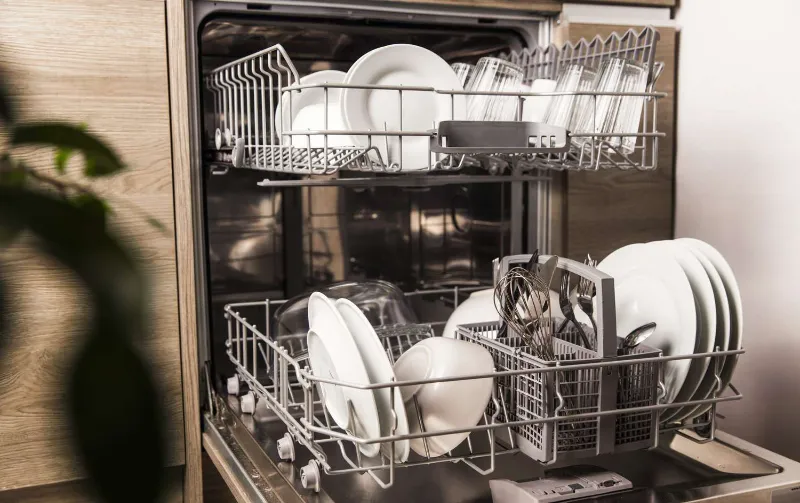A dishwasher should not be laid on its back due to the risk of damaging internal components. Transporting it upright is the safest method.
A dishwasher is a vital kitchen appliance that eases the burden of handwashing plates and utensils.
Handling a dishwasher with care during transport and installation is crucial to its functionality and longevity.
If laid on its back, the dishwasher’s delicate parts, like the motor and pump, might shift or get damaged.
This can lead to leaks or operational failures after installation. Ensuring your dishwasher remains upright maintains the integrity of its systems and prevents costly repairs.
When moving a dishwasher, secure it in an upright position and provide ample support to prevent any tilting or vibrations that could compromise its structure.
Remember, protecting your appliance during transportation is essential for enjoying the benefits of hassle-free dish cleaning without unexpected inconveniences.

Preparing The Dishwasher For Transport
Transporting a dishwasher requires specific precautions to ensure that the appliance remains intact and damage-free.
Securing the dishwasher door is a critical step in preparing the appliance for transport.
Utilize strong adhesive tape or a bungee cord to keep the door firmly closed during the move.
Transporting The Dishwasher
Transporting a dishwasher requires meticulous attention to preserve its intricate mechanisms.
Laying a dishwasher on its back can be risky and is generally discouraged. If the situation necessitates this position, it’s crucial to consult the manufacturer’s guidelines.
Certain models may tolerate being on their side better, but the back is usually the least favorable option due to the potential pressure on internal components and the risk of fluid leaks.
Before loading the appliance into a vehicle, secure any loose parts and tape the door shut.
Protecting the exterior with blankets or padding minimizes the risk of scratches and dents.
Remember, whether moving to a new home or transporting the dishwasher for repairs, gentle handling is key.
| Step | Action Checklist |
|---|---|
| 1 | Secure loose parts inside the dishwasher. |
| 2 | Tape the door to prevent it from opening. |
| 3 | Use protective materials to wrap the appliance. |
| 4 | Lift with care and avoid tilting the unit excessively. |
Aftercare And Installation
Positioning the Dishwasher correctly is a crucial step in the installation process, ensuring the longevity and efficiency of the appliance.
Laying a dishwasher on its back can lead to potential damage, so it’s imperative to keep it upright or at a safe tilt angle during transport and installation.
Proper placement also involves ensuring the dishwasher is level once positioned in its designated spot to maintain optimal performance and avoid unnecessary strain on the door seals and components.
Testing for Proper Functionality demands a methodical approach after your dishwasher has been securely installed.
Begin by inspecting all connections for leaks, especially at the water supply line and the drainage hose.
Next, run the dishwasher through a full cycle without dishes to check for any errors or irregularities in operation.
Listen for unusual noises and monitor the unit for any signs of improper drainage or water retention, which could indicate an issue with the initial installation.
Addressing these aspects immediately helps in preventing future malfunctions and ensures the dishwasher operates at peak efficiency.
Frequently Asked Questions On Can A Dishwasher Be Laid On Its Back
Can Dishwashers Be Safely Transported Horizontally?
Dishwashers should ideally remain upright during transport to avoid potential damage.
What Risks Does Horizontal Placement Pose To Dishwashers?
Laying a dishwasher on its back may dislodge internal parts or cause lubricant to leak from the compressor, risking damage and operational failures.
How Do You Secure A Dishwasher For Moving?
To secure a dishwasher for moving, empty and clean it, then lock or secure the door, and use straps to fix it tightly in an upright position on a moving dolly.
What Steps Should Be Taken Before Laying A Dishwasher Down?
If laying down is unavoidable, remove racks and secure loose parts first. Consult the manufacturer’s guide for specific instructions to minimize risk.
Conclusion
To wrap up, dealing with dishwasher transportation requires caution.
Laying a dishwasher on its back can lead to damage if not done with care.
Always consult the user manual or seek professional advice to ensure the longevity of your appliance.
Proper handling is key to a dishwasher’s safe relocation.
